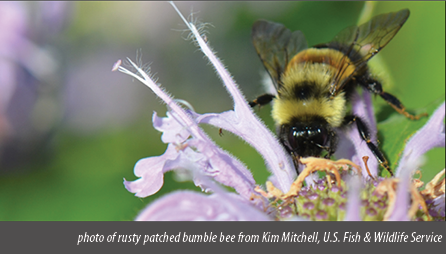Over past five years, Minnesota has emerged as national leader in efforts to protect pollinators
For lawmakers, the results of some legislative actions can be seen almost immediately — allocate funding to repair a road, for example, and it’s likely to get fixed soon. But there are other areas where the effects of a new state investment or policy only will be evident over the longer haul.

In Minnesota, Rep. Rick Hansen says, that will be the case with his state’s commitment to pollinator conservation. “Important work is often slow and results aren’t immediate,” he adds, “but you hope they are steady.” Minnesota is leading the Midwest, and most of the nation, in efforts to protect and promote the population of pollinators.
About one of every three bites of food we eat require direct pollinators, and indirectly, pollinators play a role in 75 percent of what we eat. The Midwest is home to thousands of pollinator species, including more than 400 species of native bees. But the pollinator population is at risk due to disease, the effects of pesticides, climate change and loss of habitat.
“Comprehensive policy work and habitat changes take time, something that may be limited for our pollinators,” Hansen says.
What can a state do to help? Starting in 2014, Minnesota has taken several steps, all with a focus “on supporting good science so that public dollars are used efficiently,” Hansen says. One of the first steps was to invest $4.2 million for a new bee research facility at the University of Minnesota; that school’s Bee Lab now supports the work of three researchers and investigates both native and honey bees.
Minnesota also was one of the first states to address the issue of insecticide-treated plants being sold as suitable for pollinators. HF 3172 of 2014 restricted the labeling of plants as “pollinator friendly” if they had been treated with a systemic insecticide. That legislation also gave the state-run Minnesota Zoological Garden a new statutory role — as an “official pollinator bank” to help avert the extinction of threatened and endangered pollinator species.
That same year, legislators also provided funding in the state’s supplemental budget to compensate bee owners for dead bees attributed to pesticide poisoning. Through 2018, the Minnesota Department of Agriculture had documented nine cases of acute pesticide poisoning. The state provides up to $150,000 per year for compensation and $100,000 per year to cover the inspection costs for claims.
Meanwhile, two long-running, conservation-focused funds in Minnesota — each with their own dedicated revenue sources — have helped the state advance other pollinator-friendly policies. The Outdoor Heritage Fund receives a portion of the state sales tax (the result of a constitutional amendment that raised the sales tax by three-eighths of 1 percent for 25 years).
One use of this fund is the restoration of prairie habitat, and the Legislature now ensures that any of these state-financed restorations protect pollinators. Over the last five years, too, more than $9 million in pollinator-related projects has come from Minnesota’s Environment and Natural Resource Trust Fund, which gets a portion of state lottery revenue. (Voters established this fund, via a constitutional amendment, in 1988.) That money has been used to create, restore or enhance native pollinator habitats; complete biological surveys; and conduct research on insecticides and pest management strategies.
Most recently, in 2019, the state established “Lawns to Legumes,” a $900,000 cost-share program that helps homeowners make pollinator-friendly plantings in their residential lawns. The goal of Lawns to Legumes is to provide food sources for all kinds of pollinators, but the state is particularly interested in saving the rusty patched bumble bee, an endangered species that lives in the cities of Minnesota (and has been named the official state bee).
Minnesota also was one of the first states to recognize the potential value of solar farms for pollinator habitat, establishing standards and guidelines for the developers of these sites to create “solar sanctuaries” (HF 3353/SF 2689 of 2016). Not only do neighboring fields benefit from a diverse bee population, one enterprising owner of a Minnesota apiary located hives in one of the solar farms — and now markets the product as “solar honey.”
Article written by Carolyn Orr, CSG Midwest staff liaison to the Midwestern Legislative Conference Agriculture & Natural Resources Committee.